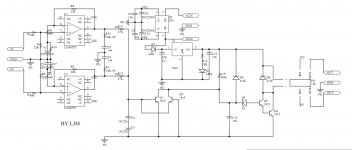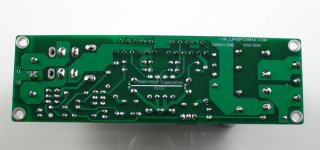Gootee
No I'm not kidding. The supplementary circuitry may have been designed by him but the amp circuit itself is standard so what bit of that did he design? It's just like all the zillions of other gainclones out there. In fact, it looks exactly the same as the Peter Daniel Audiosector implementation.
Oh dear! Gopher, I'm sorry but I am appalled by the shallowness (and the lack of decorum) of your statements, and that you have chosen to insist on persisting in the same direction.
Logically, I would also be forced to assume that you have made the same type of vacuous public insinuation about Peter Daniel's "design", in his thread. But I haven't checked. (By the way, the ESR of electrolytic capacitors does vary, quite significantly, with frequency.)
The reality is that everyone else already knows that the basic chipamp schematics are almost always roughly the same, and that, usually, because of that, any design talent or theoretical knowledge or engineering experience or expertise can mostly only begin to become apparent in the physical implementation design phase and possibly in any adjunct circuitry, or, as in Peter Daniel's case, in the design and implementation of physically/cosmetically-exquisite systems.
The physical circuit layout design is non-trivial and in the case of chipamps the design of the physical circuit layout is far more important than the schematic.
Even for a typical commercial electronic product development project, the schematic design's percentage of the total work effort involved in the project is in the single digits; usually the lower single digits.
I don't know what happened in the past but I can confidently suggest that, in general, a more-profound happiness can come from "building up" than from "tearing down".
I wish you well,
Tom
Hello Tom
I agree, we all have seen the chip amp schematics before but in the end not all chip amps have the same sound and some don't even work.
I have made my own experience where I have tested several chips with direct pin to pin wiring and I ended up with the LM3875. But I don't want to start a new discussion about the right chip, everybody can make his own experiments.
But when I designed the first board I was not happy with the sound and the only way to make real improvements was a complete new PCB design in the end.
When I was happy with the sound of the amp I noticed a very loud noise everytime I switched it off.
To solve this problem I have installed some big relais as on/off protection for the speakers. This relais are also for DC protection because I have no coupling capacitors on the output of my active system.
As stated before the schematic for a gainclone design is not everything and I like what ljm_ljm has created and shared with us.
I agree, we all have seen the chip amp schematics before but in the end not all chip amps have the same sound and some don't even work.
I have made my own experience where I have tested several chips with direct pin to pin wiring and I ended up with the LM3875. But I don't want to start a new discussion about the right chip, everybody can make his own experiments.
But when I designed the first board I was not happy with the sound and the only way to make real improvements was a complete new PCB design in the end.
When I was happy with the sound of the amp I noticed a very loud noise everytime I switched it off.
To solve this problem I have installed some big relais as on/off protection for the speakers. This relais are also for DC protection because I have no coupling capacitors on the output of my active system.
As stated before the schematic for a gainclone design is not everything and I like what ljm_ljm has created and shared with us.
Gootee
Oh dear. What a liberal dollop of typically American pseudo-psycho babble. I'm afraid you're taking it all rather too seriously. You probably think all brits are reserved and inoffensive and say 'cor blimey guv' all the time also. Where I come from we call a spade a spade, not a multi-purpose excavation implement.
I really think this whole Gainclone business has been done to death already. No matter how much you polish a turd, it's still a turd. How's that for decorum?
Oh dear. What a liberal dollop of typically American pseudo-psycho babble. I'm afraid you're taking it all rather too seriously. You probably think all brits are reserved and inoffensive and say 'cor blimey guv' all the time also. Where I come from we call a spade a spade, not a multi-purpose excavation implement.
I really think this whole Gainclone business has been done to death already. No matter how much you polish a turd, it's still a turd. How's that for decorum?
Last edited:
No matter how much you polish a turd, it's still a turd.
Polished chip amps always sound better though... the latest audiophile accessory,
Attachments
Gootee
Oh dear. What a liberal dollop of typically American pseudo-psycho babble. I'm afraid you're taking it all rather too seriously. You probably think all brits are reserved and inoffensive and say 'cor blimey guv' all the time also. Where I come from we call a spade a spade, not a multi-purpose excavation implement.
I really think this whole Gainclone business has been done to death already. No matter how much you polish a turd, it's still a turd. How's that for decorum?
Whatever.
Well I know GC3875 may be any one person are aware of.
So I do not think this is a private use. Because it is too much.
This is not a new power amplifier produced it, and want to use the design concept
I hope to be a reference to any previous one GC3875. To improve progress. This design,
The most important is not the IC 3 875, but the innovation of the circuit board design style.
So I do not think this is a private use. Because it is too much.
This is not a new power amplifier produced it, and want to use the design concept
I hope to be a reference to any previous one GC3875. To improve progress. This design,
The most important is not the IC 3 875, but the innovation of the circuit board design style.
In this circuit board has for many years of analog circuit some of the views.
NS's chip power amplifier installation, ease of use.
It is more mature compared to the next.
Again the LM3875 is not a new circuit board.
But a new concept, with a classic chip power amplifier above and, perhaps, this is just a memorial.
Thanks to National Semiconductor's chips.
NS's chip power amplifier installation, ease of use.
It is more mature compared to the next.
Again the LM3875 is not a new circuit board.
But a new concept, with a classic chip power amplifier above and, perhaps, this is just a memorial.
Thanks to National Semiconductor's chips.
Last edited:
I'd have power supply decoupling film caps near each IC.
You can parallel the IC's pins below.
Complete Reference style 47LAB 3875.
Reference 50 watts output power versions. Two 2200UF capacitor.
Integration by adding the protection circuit board .10 * 2 relay reliable.
Backside of the PCB, DC location, said the short here, the negative feedback using DC.
I've just seen your kit and I have a question. What is this DC jumper in the backside of the board? What does it do? Is it important?
Thanks
RGDS
This was a very good design, better ones I saw were often for one channel only. But after combining two boards into stereo amplifier, most are not better design any more.
I wish I can find LM3886 board having better design, so far none. But LM3875s are more expensive and have less output power.
I wish I can find LM3886 board having better design, so far none. But LM3875s are more expensive and have less output power.
Finished building, and listening impression of LJM_LJM gainclone kit
After almost a year after buying this kit, I finally found the time to build it (this afternoon). It was EASY to assemble, using 4% silver resin core solder. It took me arround 30 min to finish it. Attached a CPU heatsink to both IC's, and connected an Antek AS 2224 transformer.
Connected a mini USB DAC with no potentiometer, and my old faithful 8 ohm speakers.
Surprise, this amplifier really sound FANTASTIC!!!


Cristal clear highs, warm mids, and hard tight bass.
I'll like to say that I like it more than my old XY LM3886.
Played Jazz, Bosanova (Ana Caram), Led Zeppellin, 70's, 80's, classical, opera, Al di Meola guitar, etc at both low and high levels and there is absolutely no distortion nor clipping at all.
My 16 years old listened to it from his room (a Little apt. in the garden in the back of the house) and came running asking me what amp I was using. He was amazed!!. Now I've lost my new amplifier, but I'ts OK. I'll build another one. At $15 on ebay plus $35 Antek transformer I have to say it is one of the best buys ever. Really.
Congratulations LJM_LJM whoever you are.
After almost a year after buying this kit, I finally found the time to build it (this afternoon). It was EASY to assemble, using 4% silver resin core solder. It took me arround 30 min to finish it. Attached a CPU heatsink to both IC's, and connected an Antek AS 2224 transformer.
Connected a mini USB DAC with no potentiometer, and my old faithful 8 ohm speakers.
Surprise, this amplifier really sound FANTASTIC!!!
Cristal clear highs, warm mids, and hard tight bass.
I'll like to say that I like it more than my old XY LM3886.
Played Jazz, Bosanova (Ana Caram), Led Zeppellin, 70's, 80's, classical, opera, Al di Meola guitar, etc at both low and high levels and there is absolutely no distortion nor clipping at all.
My 16 years old listened to it from his room (a Little apt. in the garden in the back of the house) and came running asking me what amp I was using. He was amazed!!. Now I've lost my new amplifier, but I'ts OK. I'll build another one. At $15 on ebay plus $35 Antek transformer I have to say it is one of the best buys ever. Really.
Congratulations LJM_LJM whoever you are.
According to ljm_ljm schematic ( View attachment 339310 ), is it possible to add a switch to these points ( View attachment 339311 ) to "SWITCH" between DC coupling and Capacitive coupling?
Thanks, Pemo
Is a convenient shortened C1 C2 way.
I think the tin, will be more stable than pin.
Don't be in general.
It will bring higher DC output.
Although the voltage is still very low.
Hi ljm!
I'm a newb and I have a couple of dumb questions. While I do understand some of the basic things in the circuit, I don't understand this:
1. Why would we need Q1, Q2 followed by a Darlington pair Q3, Q4 when the IC itself is quite capable of giving out several watts?
2. If there was nothing else (the transistor circuit part) to be used after the ICs, we would have outputs (L/R) right after R12 and R13, right? Then how do we get L/R channels after they have been shorted out and fed into Q1?
Again, I think my questions are kindergarten level stuff, so please point me in the right direction here. If there is anything I could read-up which in turn would help me figure out the things here, please let me know.
Thanks in advance!
Aashish
I'm a newb and I have a couple of dumb questions. While I do understand some of the basic things in the circuit, I don't understand this:
1. Why would we need Q1, Q2 followed by a Darlington pair Q3, Q4 when the IC itself is quite capable of giving out several watts?
2. If there was nothing else (the transistor circuit part) to be used after the ICs, we would have outputs (L/R) right after R12 and R13, right? Then how do we get L/R channels after they have been shorted out and fed into Q1?
Again, I think my questions are kindergarten level stuff, so please point me in the right direction here. If there is anything I could read-up which in turn would help me figure out the things here, please let me know.
Thanks in advance!
Aashish
- Status
- This old topic is closed. If you want to reopen this topic, contact a moderator using the "Report Post" button.
- Home
- Amplifiers
- Chip Amps
- I designed the GC LM3875


